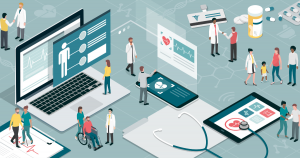Technology is often championed, or criticized, for disrupting multiple industries. However, the reality is it’s our own rising expectations that’s really driving the digital transformation of everything.
The new standard of seamless, one-touch or one-swipe experiences across myriad devices has been set by the likes of Amazon, Netflix, Uber, and Airbnb. Organizations from all verticals are learning that it’s both their legacy technology and mindsets that are preventing them from meeting the rising demands of their audience in a digital, customer-centric age.
Predictably, as we’ve seen over the last several years, patients now expect the same digital experiences from their healthcare provider too. “Driven by experiences outside of healthcare, consumers increasingly expect to use digital technologies to control when, where and how they receive care services,” said Kaveh Safavi, M.D., J.D., who heads up Accenture’s(a) global health practice. “By harnessing digital technologies in this way, healthcare will increasingly…put control in the patients’ hands.”
As patients become more involved and invested in their own wellness by leveraging technology, healthcare organizations must also reimagine the experience they provide to thrive in a digital age. This requires adopting more of a predictive and responsive approach based on patient behavior and data to not only enhance the experience, but also improve outcomes all around.
Though most organizations are aware of this, many are finding themselves with glaring gaps in their patient experience and without the right technological foundation to support it. So, how do you build a great patient experience?
Identify The Patients’ Needs
Increasingly, patients are being referred to as “healthcare consumers” and this is, in large part, because consumerization has spread to nearly every corner of the industry. Additionally, consumers are now taking a front seat in directing their care and expect a more personalized experience and the ability to plug in to the intelligent technologies that make managing their health easy and accessible.
As a result, they’re doing more research to not only select providers who are prepared to meet them where they are, but also inform healthcare decisions. And while many assumptions can be made about what they want –– convenience, affordability, and quality of care –– we can no longer rely on presumptions. The fact is, today healthcare consumers are increasingly turning to self-service digital health tools like electronic health records (EHRs), online communities, wearable devices, and mobile apps to create their own connected experiences. And their wants and needs are as varied as they are. In other words, there’s no one-size-fits-all approach.
To meet patients where they are, you must take a walk in their shoes to understand their journey. How and where are they searching for care? Do they expect to have access to virtual healthcare services? According to a study(b) by Accenture, while patients still prefer in-person care, nearly half want access to virtual care options in off hours or when there are delays in scheduling.
Do your patients want access to their EHRs? If so, what data do they want access too? The same study found, of those who have accessed their EHRs, a vast majority do so to see blood-test results or reference physician notes and information about their medical conditions. There are numerous other data points they can access in an EHR but knowing what matters to them is equally as important as providing the platform to provide personalized service and anticipate their needs.
But not all healthcare IT systems make data easily accessible. And most legacy platforms weren’t built to support the collaborative care model. To deliver a cohesive and connected experience from the first marketing touchpoint through to medical billing, it requires a combination of dynamic technology like cloud based EHRs, patient relationship management solutions (like Salesforce Health Cloud and Salesforce Industries for Healthcare), and integration platforms like MuleSoft’s Anypoint that enable the exchange of data between applications.
Create One-To-One Experiences
Across nearly every aspect of their lives, consumers are routinely served personalized experiences by a web of intelligent technology and complex algorithms that are considering their actions and behaviors. And in healthcare, this same smart technology is being used to not only send personalized appointment reminders and home care plans, but also inform those care plans to improve outcomes.
This is where tools like artificial intelligence (AI) come into the picture. Intelligence technology such as Salesforce Einstein is being used to predict outcomes, recommend actions, and automate tasks to add a “smart” layer to CRMs and health information systems, as well as to inform care plans based on historical data to improve health outcomes.
As these tools gather outcomes data across the patient population as a whole and the specific behaviors of the individual patient, they can be leveraged to not only help improve the experience and delivery of care, but also reduce readmissions in the hospital setting, which is a key factor in the value-based care equation.
Build Collaborative Patient Communities
Healthcare in the digital age needs to be more accessible and collaborative to meet the rising expectations of today’s healthcare consumer. And the integration of data across multiple systems has become a foundation to creating a more collaborative care culture – an achievable reality with the healthcare offering within the Salesforce ecosystem.
Much of the industry, however, is at a crossroads right now trying to figure out how to extract data out of siloed systems, share it across the patient’s care team and derive meaning from the data being shared. To solve this, some organizations have turned to cloud-based systems and application programming interfaces (APIs) to make data more accessible and create centralized hubs for both providers and patients to interact. And this is rapidly becoming a mission-critical part of the patient experience –– providers need to have access to real-time health records and be able to collaborate with one another, and patients want to be able to access their records and their care teams when they have a question.
Today’s healthcare consumers have little interest in persevering the traditional approach to healthcare and are driving radical changes by demanding more from medical providers and choosing those that offer digital capabilities. And keep in mind while technology may have started the digital transformation, it’s consumer expectation that’s driving the biggest industry in healthcare. Are you meeting the demand?








